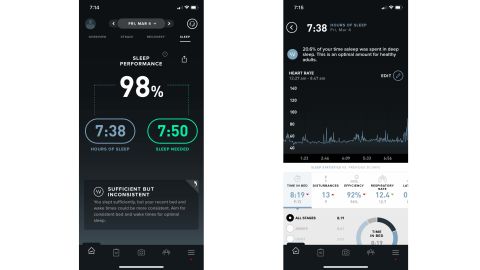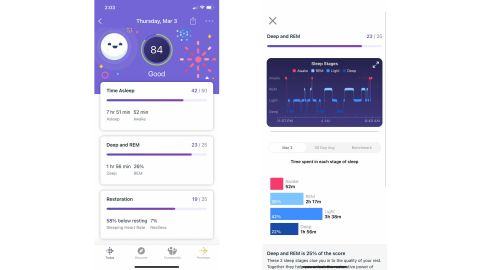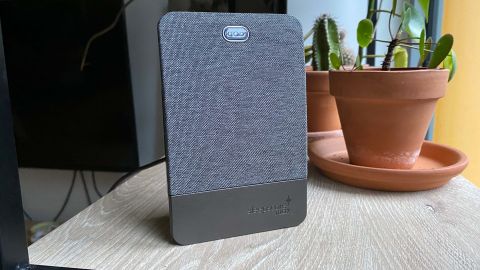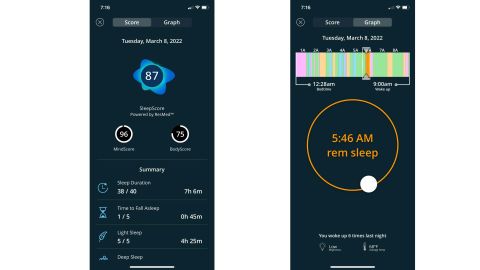This article is a part of CNN Underscored’s Guide to Sleep, a week-long focus on everything you need to sleep better. We’ll be featuring new products and exclusive deals all week, so check in every morning to see what’s new and be sure to subscribe to the CNN Underscored newsletter to see it all.
There are many ways to get a better night’s sleep, whether it’s upgrading your pillows and sheets, using a white noise machine or even replacing your mattress entirely. But if you still have mornings where you feel groggy and tired but just don’t know why, a sleep tracker could be a useful tool to help you improve your sleep.
To see which sleep tracker is the best, we tested 15 of the most popular options on the market over the course of two weeks. We used multiple trackers at the same time so we could compare data from each, and while many of the trackers we tested have fitness tracking capabilities as well, we only tested and ranked their sleep features.
After weeks of rigorous testing and countless zzz’s logged and analyzed, here are the three sleep trackers that stood out above the rest.
Our favorite fitness tracker, the Fitbit Inspire 2 is also a great sleep tracker. The small watch is comfortable to wear and provides nearly as much data as the Whoop Strap. We found its app a tad harder to navigate, but it has a best-in-class 10-day battery life and has a lower monthly price for its sleep tracking features.
$30 per month with a 6-month membership at Whoop

The Whoop Strap 4.0 accurately and comfortably tracks all sorts of data from REM stages and efficiency to heart rate and respiratory rate, all while displaying it in an easy-to-understand way every morning.
If you’re looking to further understand your sleep, the Whoop 4.0 tracks basically anything and everything you’d want to measure. It automatically detects when you go to bed, when you wake up, how much time you actually were asleep, how many times you woke up in the middle of the night, your respiratory rate and your sleep stages, including deep sleep, REM and more. Some of these data points are more useful than others; however, by providing all of them Whoop gives its users a comprehensive look of each night’s rest.
While more data seems great, our biggest worry with the Whoop and many other trackers we tested was if we’d be able to make sense of all the data they provide. But through the Whoop app (available on iOS and Android), you can easily get a quick overview or dig deep into the numbers of any sleep session. Whoop’s data presentation was the easiest to understand of any of the trackers we tried, as it gives you an overall recovery score and sleep percentage every morning, along with data comparisons to your averages so you know how you slept in an instant.
The recovery score takes into account more than just sleep (you can read more about it in our full review of the Whoop 4.0 here), but the sleep score measures the time you actually spent asleep (which is a lot less than the time you spend in bed) against how much sleep you needed as a percentage. This was an extremely useful feature as you can easily see when your percentage is low and try to adjust your schedule and reserve more time for rest.
And if you want a more detailed look into the other data like your sleep stages, you can simply click on your sleep session and the Whoop will show your measurements, along with little green or red arrows to show if last night’s readings were better or worse than your weekly average. Had a late night drinking? Expect red arrows. Went to bed early and read for thirty minutes before you fell asleep? You’ll probably see green arrows in the morning.

This simple comparison is a great motivator to try and get better sleep every night. But since it’s often hard to figure out what affects your quality of sleep — besides how long you’re in bed — Whoop has a daily journal function so you can log activity that might affect your sleep. You can customize your journal to ask about stress levels, hydration, alcohol consumption and all sorts of other health-related topics. Then, Whoop will match up your answers to your data and give you insights on how to improve your sleep and health every month through a monthly performance assessment.
While Whoop makes it easy to understand what affects your sleep, all this tracking would be for nothing if it wasn’t comfortable and easy to wear and use. Wearing multiple sleep trackers at once wasn’t a very comfortable experience, but the Whoop is smaller and thinner than many of the other options we tested and its knit band felt more comfortable than the silicone straps of other trackers. The downside to this band, though, is that it utilizes a clasp system that isn’t easily adjustable, so if you wake up in the middle of the night you can’t just unbuckle the strap by one hole like a smartwatch, you have to take the whole thing off and carefully fix the sizing.
Once you find your perfect fit with a little bit of trial and error, you’ll barely feel the Whoop on your wrist. However, if it’s still uncomfortable at night, the brand has a line of activewear called Whoop Body that allows you to put the sensor in a piece of clothing so you can track no matter what. We tried putting the tracker in a pair of boxers for several nights during testing and though it was uncomfortable when laying directly on it, we quickly got used to it. It’s a great alternative way to track, however, these pieces can be pretty pricey ($69 for a two-pack of boxers), so it’d be an investment to stock your drawer enough to be able to sleep with them every night.
On top of its comfort, the Whoop 4.0 had the best charging system of any wearable tracker we tried. Instead of taking the strap off and connecting it to a charger, Whoop has a battery pack that slides right on top of the tracker so you never have to take it off. So even if the battery is running low right before bed — which it rarely does thanks to its five-day battery life — you’ll never have to skip a night of tracking.
As we point out in our review, our biggest issue with the Whoop 4.0 is its pricing structure. You don’t have to buy the strap itself, but you do have to subscribe to a monthly membership. You can start out for just $30 per month if you sign up for a six-month membership or commit to a longer membership such as one for 24 months and pay as low as $20 per month up front, totaling $480.
However, if you can swing the monthly price, the Whoop 4.0 gives you an abundant amount of data in a clear, concise and actionable way so you can not only track your sleep, but improve it.
Runner-up and best sleep tracker with fitness tracking: Fitbit Inspire 2
$99.95 $84.99 at Amazon or $99.95 at REI and Fitbit

If you want a sleep tracker that’s cheaper than the Whoop and comes with a screen to tell the time and send you notifications, the Fitbit Inspire 2 is your best bet. It tracks nearly the same amount of data as our favorite tracker and has an even longer battery life, clocking in at an incredible 10 days.
We tested three Fitbit trackers for their sleep tracking capabilities, but between the Inspire 2, the Charge 5 and the Sense, the Fitbit Inspire 2 topped them all thanks to its thin design and low price. The small face made it more comfortable to wear at night than the Sense, and while the Charge 5 is just $30 more expensive at $129, the Inspire 2 has a longer 10-day battery life compared to the Charge 5’s 7-day tank.
When tracking our sleep with the Inspire 2, it was incredibly accurate and consistent, similar to the Whoop Strap. There were a few nights that we missed out on complete data because of a poor fit, but we quickly resolved that issue and ensured the strap was on tight enough for proper measurements.
The Fitbit Inspire 2 automatically tracked bedtimes and wake times, disturbances, sleep stages and heart rate. Compared to the Whoop, the only datapoint of note the Inspire 2 didn’t track was respiratory rate. But even without that measurement, the Inspire 2 gives you a great snapshot of your sleep with an overall sleep score and different breakdowns of your data.
Interpreting the data on the Fitbit app (also available for iOS and Android) wasn’t as easy as the Whoop, but still wasn’t difficult. You can select your sleep session then select different data groups including time asleep, sleep stages and restoration to dig into your measurements.
For example, when you look at a night of sleep, you can see that you spent a certain amount of time in deep sleep and REM, but if you wanted to learn more you could click in deeper and look at a graph that shows you when exactly during the night you were in all stages of sleep including deep, REM, light and even awake. You can then compare your measurements to your 30-day average to see your quality of sleep to get a better idea of how you slept. This feature is similar to Whoop’s comparison with your 7-day average, but you have to dig a little deeper to get it.

In terms of comfort, the silicone band was more uncomfortable than the Whoop’s knit strap, however, since the Inspire 2 is so thin, we quickly forgot it was there.
The Fitbit Inspire 2 is a great sleep tracker that can measure all the most important data you need to examine your nights. It isn’t as comprehensive or easy to digest as the Whoop, but it does have a lower price tag. The Inspire 2 is $99.99 and with that you get one free year of Fitbit Premium, which is required to get the band’s deep sleep insights. Once your free year is over, Fitbit Premium costs $9.99 per month or $79.99 for an annual membership.
On top of being cheaper, the Fitbit Inspire 2 is also our favorite fitness tracker, which makes integrating sleep into your holistic health routine easier than ever. The Whoop 4.0 is a great fitness tracker in its own right too, so it’s really up to your preference.
Best non-wearable sleep tracker: SleepScore Max
$149.99 at SleepScore and Walmart

If there was one thing we noticed throughout our testing, it’s that wearing a sleep tracker all night long can be very uncomfortable. Whether it’s on your wrist, finger, forehead or even in your ears, there’s always a period of discomfort before you get used to having a tracker on your body for the night.
That’s why we grew fond of the sleep trackers that you didn’t need to wear, especially the SleepScore Max. The SleepScore Max can live on your bedside table and all you have to do to track your sleep is point the device at your chest. It uses a bio-motion sensor technology (think echolocation) to track your breathing and body movement during sleep and, during our testing, it was surprisingly accurate and consistent.
The SleepScore Max doesn’t track as much data as a wearable, but it does track sleep duration, all the different sleep stages and the time it takes you to fall asleep. Every morning it gives you a sleep score out of 100, and a quick overview of your data. You can also look at a graph that shows you when you were in the different sleep stages.

Like the Whoop and Fitbit, the SleepScore Max app has plenty of tips on how to get a better night’s rest, whether that’s how to ensure your bedroom is quiet enough and the temperature is right, or articles exploring the pros and cons of listening to music while you sleep. It also has a daily log where you can rate your caffeine and alcohol consumption, exercise, stress and sleepiness to gain more insight into how your sleep affects your day and vice versa.
The biggest issue we had with the SleepScore Max, however, is that it doesn’t automatically start and stop tracking. You have to manually begin your session at night and stop it in the morning, which is a bit annoying. If you forget to turn it on before you go to bed, it won’t track at all and if you forget to stop your session in the morning, your data will be skewed.
On the plus side, the SleepScore Max thankfully doesn’t have a monthly subscription like many of the other trackers we tested and the $149.99 price tag isn’t outrageous.
So if you want an accurate sleep tracker that you don’t have to wear and charge all the time, check out the SleepScore Max. It doesn’t provide as much data as other options, but it was the most accurate non-wearable tracker we tested and its convenience is second to none.
How we tested
To assess data accuracy, we wore multiple trackers at the same time and compared each device’s data. We also took into account how consistent each tracker was and if it missed any nights of tracking. We counted how many data points each tracker measured, and looked through the app and judged how easy it was to interpret the trackers’ data and change your sleep routine.
We paid careful attention to how comfortable each tracker was to wear at night and judged how the tracker felt and looked while using it.
We also took note of any features that are designed to help you fall asleep, such as meditations, as well as alarms and other wake-up features.
To assess battery life, we charged each tracker to full and noted how long it took to drain during testing. We downloaded each companion app and judged how easy it was to use, checking to see if the tracker and app could share data with Apple Health and Google Fit.
We paid careful attention to how comfortable each tracker was to wear at night, judged how the tracker felt and looked while using it and examined each tracker after testing and looked for any damage including scratches and scuffs.
Everything else we tested
Oura Ring Generation 3
$299 at Oura Ring
The Oura Ring was a reliable sleep tracker and consistently measured data accurately and easily. It was also the most comfortable sleep tracker that we wore at night, since it lives on your finger instead of on your wrist. If you don’t like the Whoop or the Fitbit Inspire 2, the Oura Ring is a fantastic sleep tracker that won’t disappoint. However, its sizing can be hit or miss (Oura does send a sizing kit to give you the best chance of finding a good fit), we thought the app wasn’t as easy to navigate as the Whoop’s or the Fitbit’s and the Oura carries a whopping $300 price tag, with a $5.99 monthly subscription after a 6-month trial period. But if you’re okay with the price, the Oura is a great option for people who don’t want to wear a tracker on their wrist.
Muse S (Gen 2)
$399.99 at Muse
We had some initial tracking problems with the Muse S Gen 2, but after some quick troubleshooting (the plastic legs of the pod didn’t completely lock into the headband) we didn’t have other issues with tracking. The measurements were accurate and similar to the results we got from other trackers, but the headband itself was quite uncomfortable to wear throughout the night. You also have to manually start and stop tracking on the Muse S, which along with a battery life that only lasts for one night kept it out of contention.
Sleepon Go2sleep
$129 $89 at Sleepon
The Sleepon Go2sleep is another sleep tracker that fits on your finger, and while it was more comfortable than most wrist trackers, we definitely noticed it more throughout the night than the Oura. Its battery doesn’t last as long as the Oura and it isn’t as easy to interpret your sleep data through the app, so we’d suggest you opt for the Oura Ring if you want a tracker for your finger.
Amazon Halo Band
$99.99 $54.99 at Amazon
The Amazon Halo also tracked sleep consistently and accurately, but like the Fitbit Inspire 2, didn’t track respiratory rate. The app is pretty easy to navigate too, but unfortunately the Amazon Halo can’t pair with Apple Health or Google Fit, which nearly all of the other trackers we tested could. It’s a solid, though somewhat creepy tracker that might be right for you if you have a lot of Alexa-enabled devices.
Apple Watch Series 7
From $339 at Walmart or $399 from $349 at Amazon
Our favorite smartwatch has a multitude of features that help you improve your fitness and overall health, but when it comes to sleep tracking, Apple omits the complicated data that might just get confusing and focuses on the factor that you can control the most — the amount of sleep you get. The Apple Watch Series 7 does track your respiratory rate and heart rate while you’re in bed, but only presents you with your sleep duration every morning. The Apple Watch pairs with your iPhone and sends you reminders to go to sleep, which is a nice holistic approach to getting more sleep, unfortunately it’s just not as feature-filled as many of the other trackers we tested.
Galaxy Watch 4
$249.99 From $219.99 at Samsung
The Galaxy Watch 4 is our favorite smartwatch for Android users, but it has similar shortcomings as a pure sleep tracker as the Apple Watch. It tracks more than the Apple Watch, including sleep stages, but not as much as many of the other trackers we tested. However, if you’re looking for the best Android smartwatch and sleep tracking is secondary, the Galaxy Watch 4 is definitely the one for you.
Fitbit Charge 5
$179.95 $129.95 at Amazon and Fitbit or $179.95 $129.99 at REI
The Fitbit Charge 5 had great sleep tracking, similar to the Fitbit Inspire 2. It also has a thin profile, meaning it was more comfortable than some other trackers throughout the night, but it doesn’t have the same battery life as the Inspire 2.
Fitbit Sense
$299.95 at REI or Fitbit
The Fitbit Sense has a larger screen and band than the Fitbit Charge 5 and the Fitbit Inspire 2, so it wasn’t as comfortable wearing it all night long. Plus, coming in at $299.95, we think you can get a better sleep tracking experience for much less with the Inspire 2.
Biostrap Recover Set
$319 at Biostrap
The Biostrap tracked a large amount of sleep data, including respiratory rate, sleep stages, blood oxygen levels and more. However, there were some nights that didn’t track during our testing and the charging system for the Biostrap was very annoying. Instead of plugging the Biostrap into an outlet with a cord, it came with a charger that you had to balance the Biostrap on to charge. It didn’t hold the strap securely, so there were several times where we thought the Biostrap was charging but we had accidentally knocked it off the charger.
Withings Sleep
$99.95 $74.96 at Withings
This sleep tracker goes underneath your bed to automatically track your sleep duration, sleep stages and more. We thought it was a great idea, however in our testing it provided results that weren’t as accurate as many of the other trackers we tested. And since the pad goes underneath the bed, if you sleep with a partner it can skew the data, especially if they roll over in the morning after you get up. Not to mention if you decide to work from bed one morning, the Withings Sleep Pad might think you’re still asleep, leading to inaccurate data.
Amazfit Zenbuds Smart Sleep Earbuds
$149.99 at Amazon
Out of all the ways to track sleep, we liked sleep earbuds the least. The Amazfit Zenbuds fell out most nights we tried to wear them, leading to inconsistent tracking. The app was also quite buggy and would crash every now and then.
Kokoon NightBuds
$249.99 $199.99 at Kokoon
The Kokoon NightBuds stayed in our ears better than the Amazfit Zenbuds, but we still had a lot of trouble getting them to track our sleep. After eight nights of trying to use them, we were only able to get one night of data. They were also quite uncomfortable to wear throughout the night and they hurt our ears whenever we tried to sleep on our side.
Source: www.cnn.com



